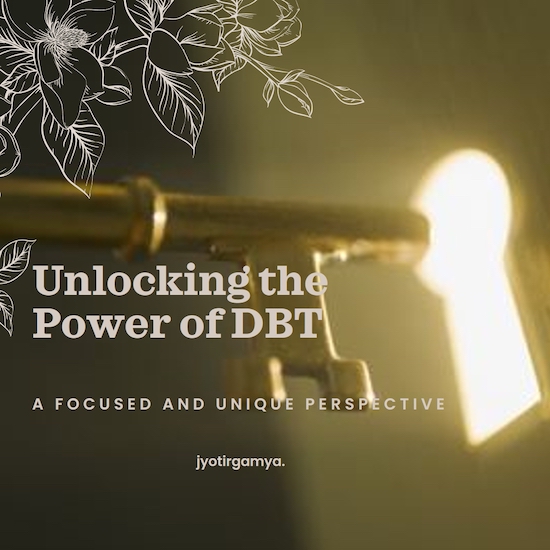Unlocking the Power of DBT: A Focused and Unique Perspective
Ever sit at your desk, chest tight, phone notifications buzzing like angry hornets?
Or have deadlines loom like rain clouds, making your to-do list heavier than a backpack full of textbooks?

Welcome to the wonderful world of work stress, where emotions can run wild and productivity takes a nosedive.
But hold on, before you pack it all in and chase alpacas in Peru, there’s a secret weapon in our arsenal Dialectical Behavior Therapy (DBT).
Yes, it’s a fancy name, but it’s a toolbox of practical skills to handle those workplace demons like a superhero. So, let’s dive into how DBT can be your cape in the storm of office life.
Exploring DBT in Depth Beyond the Basics

At the heart of DBT lies core skills that serve as the foundation for emotional well-being.
Let’s delve into these essential building blocks, understanding how they form the bedrock of a harmonious and productive workplace environment.
Think of these DBT skills as superpowers for your emotional brain
-
Mindfulness: Like a superhero seeing through walls, you become aware of your thoughts and feelings as they arise, without getting tangled in them. No judgment, just clear observation.
-
Emotional Regulation: Feeling like a volcano about to erupt? DBT teaches you calming techniques like deep breaths and soothing imagery to cool down your brain’s lava before it flows.
-
Interpersonal Effectiveness: Imagine words as magical shields and swords. DBT equips you to express your needs clearly, listen with superpowers, and set healthy boundaries to protect yourself and build strong relationships.
-
Distress Tolerance: Life throws curveballs, some harder than others. DBT gives you tools to face them like a ninja, using distraction techniques and accepting things you can’t control.
Connecting the DBT Dots
These skills aren’t solo acts; they work together like a brain-boosting Avengers team. For example, when you’re mindful of your stress rising (thanks, deadline monster!), you can use your emotional regulation powers to calm down. Then, with clear communication skills, you can talk to your boss about a manageable workload. See how they connect?
Building Your Workplace Zen
The more you practice these DBT skills, the stronger your brain’s resilience becomes. You’ll be better equipped to handle emotional storms, build healthy relationships with colleagues, and maintain a calm and productive focus throughout your workday. Remember, it’s like training your brain to be a zen master in a sometimes-crazy work world.
Narrowing the Focus Workplace Applications of DBT
Workplace stress? You’re not alone. Thankfully, Dialectical Behavior Therapy offers a practical toolkit to overcome these challenges and thrive in a demanding environment.

Tailored for the Workplace
While traditionally used in therapeutic settings, DBT skills can be effectively adapted to empower professionals. This evidence-based approach equips you with strategies to
-
Manage Emotional Challenges: Learn to regulate stress, anxiety, and frustration in the face of professional pressures. DBT offers de-escalation techniques to maintain composure during even the most challenging situations.
-
Enhance Communication: Foster effective communication with colleagues and clients. DBT skills improve assertiveness, conflict resolution, and active listening, leading to stronger relationships and collaboration.
-
Increase Focus and Productivity: Develop strategies to prioritize tasks, minimize distractions, and optimize your workload. DBT teaches mindfulness techniques to stay present and focused, maximizing your output while minimizing stress.
-
Build Resilience: Cultivate emotional resilience to bounce back from setbacks and challenges with greater ease. DBT empowers you to learn from mistakes, adapt to change, and maintain a positive outlook in the face of adversity.
Actionable Steps for Real-World Scenarios
Ready to put DBT into action? Here are some practical applications
-
Presentation Jitters: Implement mindfulness techniques like deep breathing and visualization to manage pre-presentation anxiety. Focus on your strengths and deliver your message with confidence.
-
Overflowing Inbox: Utilize DBT skills for prioritization and assertiveness. Learn to say “no” to non-essential tasks and set clear boundaries with colleagues regarding email expectations.
-
Difficult Feedback: Approach feedback with a growth mindset and utilize DBT communication skills to actively listen, ask clarifying questions, and express your concerns constructively.
Empowering Your Professional Journey
Remember, DBT is a journey, not a destination. Consistent practice is key to integrating these skills into your daily routine and reaping the benefits. With dedication, you can transform your workplace experience, navigate challenges with greater ease, and unlock your full professional potential.
The tools are in your hands, ready to help you conquer those workday woes and claim your professional victory!
Addressing Criticisms and Misconceptions
DBT comes with its fair share of questions and sometimes, even some doubts. Let’s take a moment to address some common concerns and misunderstandings surrounding DBT, exploring its benefits and limitations in the professional setting.
1. “DBT is just for people with serious mental illness.”
While DBT was initially developed for individuals with borderline personality disorder, its effectiveness extends far beyond. Its core skills, like managing emotions, improving communication, and building healthy relationships, can benefit anyone seeking to navigate daily challenges, stress, and interpersonal conflicts – challenges we all face in the workplace.
2. “DBT makes you weak or overly emotional.”
Quite the opposite! DBT empowers individuals to understand and regulate their emotions, not suppress them. It equips you with practical tools to express yourself clearly and assertively, fostering respectful and productive communication in the workplace.
3. “DBT takes too long to see results.”
Like any worthwhile skill, mastering DBT takes time and consistent practice. However, even basic mindfulness and emotion regulation techniques can offer immediate benefits, reducing stress, improving focus, and fostering a more resilient approach to workplace challenges.
4. “DBT sounds too complicated for a busy workplace.”
The beauty of DBT lies in its practical, down-to-earth approach. Its skills are designed to be easily integrated into daily life, including the workplace. Simple mindfulness exercises, clear communication strategies, and interpersonal effectiveness tactics can be woven into everyday interactions, subtly leading to significant improvements.
By addressing these common concerns and misconceptions, we can see DBT for what it truly is – a valuable tool for navigating the emotional complexities of the workplace, contributing to increased well-being, improved communication, and ultimately, a more productive and thriving professional environment.
Conclusion
We’ve explored DBT through a brain-focused lens, revealing its practical power to transform your work life. Remember, DBT isn’t magic, but it’s like giving your brain a cool upgrade with mindfulness, emotion-taming skills, and communication superpowers.
Let’s recap the key takeaways
Your DBT Toolbox
-
Mindfulness: This anchor skill helps you see your thoughts and feelings clearly, like watching clouds drift by. No judgment, just awareness.
-
Emotional Regulation: Feeling overwhelmed? DBT gives you tricks to calm your brain’s storm, like taking deep breaths or using soothing imagery.
-
Interpersonal Effectiveness: Think of this as super communication. DBT teaches you how to express your needs clearly, listen actively, and set healthy boundaries.
-
Distress Tolerance: Life throws curveballs. DBT equips you with tools to face them without breaking, like distraction techniques and accepting what you can’t control.
Actionable Insights for Your Workday
-
Mini-meditations: Take brain breaks! Even a few minutes of mindful breathing can recharge your focus and reduce stress.
-
Body scan: Check in with your body. Are you clenching your jaw? Release tension and notice physical sensations without judgment.
-
Mindful communication: Before reacting, pause and observe. Listen actively, express yourself clearly, and avoid mind-reading.
-
Challenge negative thoughts: Don’t believe everything your brain tells you. Question self-doubt and replace it with kind, realistic thoughts.

By understanding the science behind DBT, you gain a deeper appreciation for its effectiveness. It’s not just “feel-good” stuff; it’s rewiring your brain for better emotional regulation and healthier relationships.
So, why not give DBT a try? Implement these simple strategies in your workday and see the magic unfold. Reduced stress, improved communication, and a calmer, more productive you await. Remember, your brain is powerful, and DBT gives you the tools to unlock its full potential.
Go forth and conquer your workday with the wisdom of neuroscience and the power of DBT!
Related Articles
Seventy One New Year Resolution Ideas
Servant Leadership Strategies for a Healthy, Productive Workplace
Perfectionism Paralysis: Unleashing Innovation with Servant Leadership
Social Media Addiction Symptoms: Guide to Identifying Signs and Seeking Help
The 10X Rule Unveiled: Exploring Grant Cordone’s Approach to Success and Evidence-Based Alternatives
The Fallout of Toxic Leadership: A Story of Burnout and Redemption
Understanding Jealousy and Envy Causes, Consequences, Treatment, and Coping Strategies
A Systemic Approach to Addressing Burnout
Managing Anxiety: Strategies for Coping with the Different Aspects of Anxiety
Building Strong Relationships: Insights from the Experts
Want to stay connected? Here’s our twitter.
Or subscribe to our monthly newsletter containing tools for body, mind, and goal.